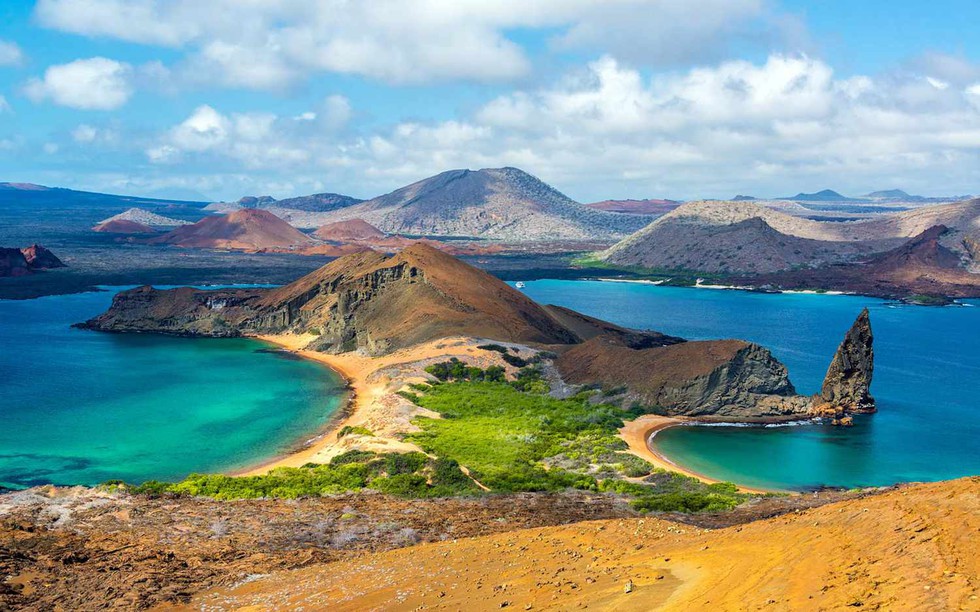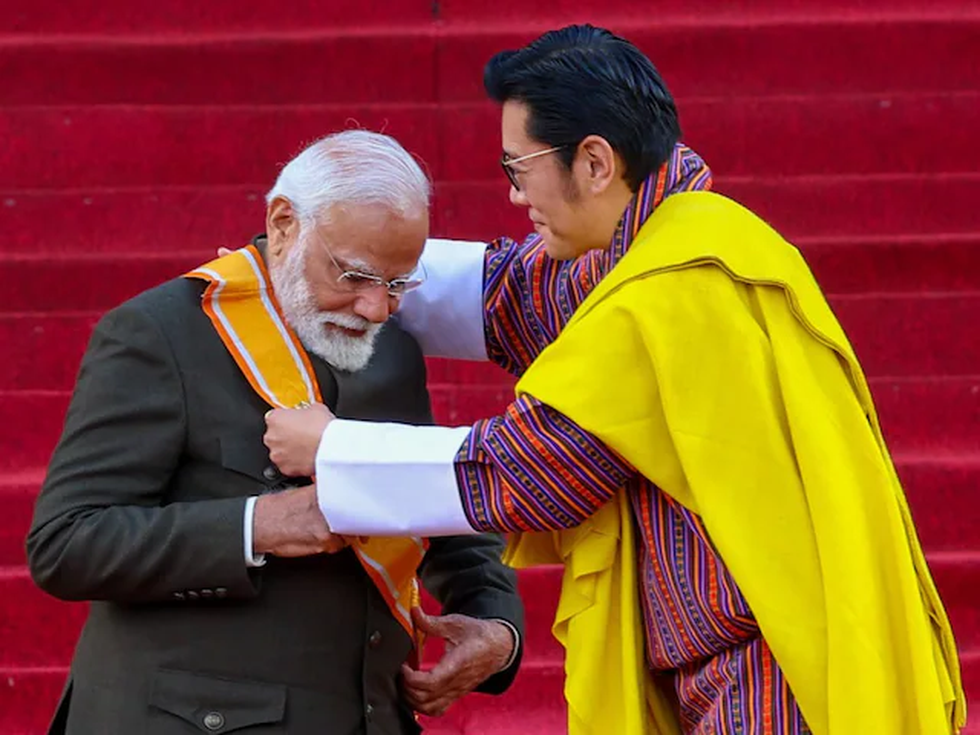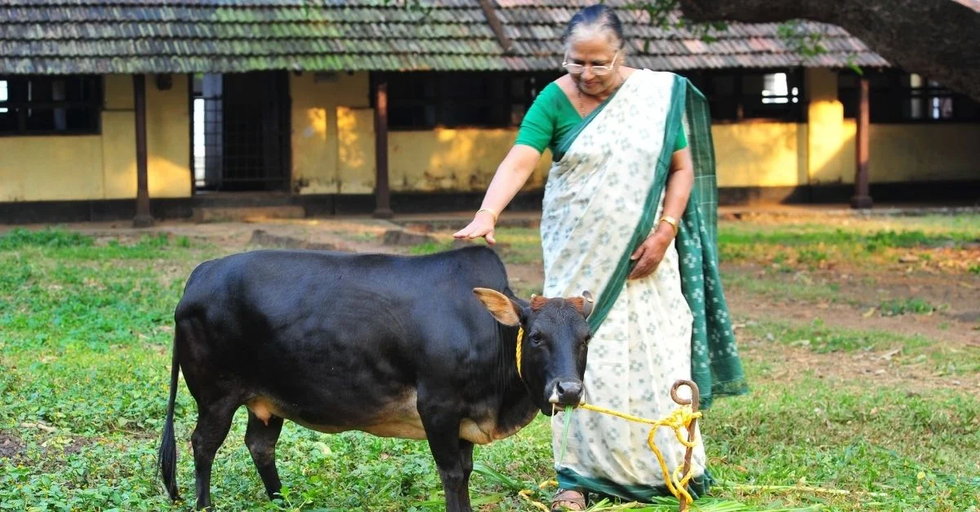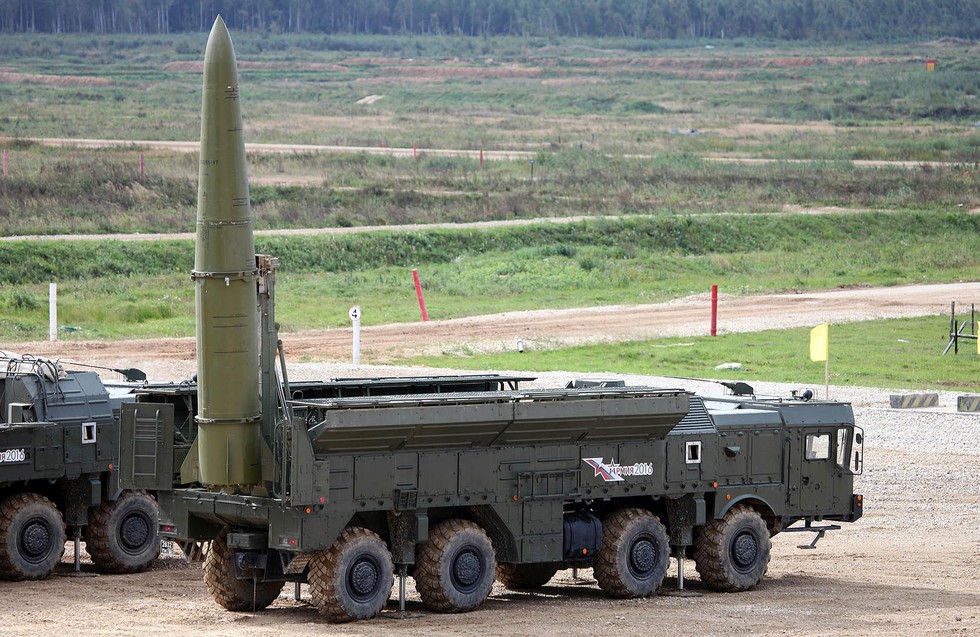
About Sea Cucumber:
- These are part of a larger animal group called echinoderms and are invertebrates that live on the seafloor. Their body shape is similar to a cucumber, but they have small tentacle-like tube feet that are used for locomotion and feeding.
- They are found in all marine environments throughout the world, from shallow to deep-sea environments. Sea cucumbers are benthic, meaning they live on the ocean floor.
- They excrete inorganic nitrogen and phosphorus, enhancing the productivity of benthic biota.
- Reproduction:
- Sea cucumbers exhibit both sexual and asexual reproduction.
- Unlike most terrestrial animals, sea cucumber eggs undergo external fertilization—females release eggs into the water that are fertilized when they come into contact with sperm that males have released.
- Conservation status:
- Wildlife Protection Act of 1972: Schedule I
- CITES: Appendix II
2. Galapagos Islands

About Galapagos Islands:
- Location: It is situated in the Pacific Ocean. It is distributed on either side of the Equator with an underwater wildlife spectacle with abundant life.
- Repeated volcanic eruptions helped to form the rugged mountain landscape of the Galápagos Islands.
- In comparison with most oceanic archipelagos, the Galapagos are very young with the largest, and youngest islands, Isabela and Fernandina, with less than one million years of existence and the oldest islands, Española and San Cristóbal, somewhere between three to five million years.
- Mount Azul, at 5,541 feet, is the highest point of the Galapagos Islands.
- Climate: It is characterized by low rainfall, low humidity, and relatively low air and water temperatures.
- It is designated as a UNESCO World Heritage site in 1978.
- Biodiversity:
- The Galápagos are best known for many species are endemic, as they are not found anywhere else in the world.
- These include the giant Galápagos tortoise (Chelonoidis nigra), the marine iguana (Amblyrhynchus cristatus), the flightless cormorant (Phalacrocoraz harrisi), and theGalápagos penguin.
- The Galápagos penguin (Spheniscus mendiculus) is the only penguin species to live in the Northern Hemisphere.
3. Signals Technology Evaluation and Adaptation Group (STEAG)

About Signals Technology Evaluation and Adaptation Group:
- It is a unit dedicated to researching and evaluating futuristic communication technologies like 6G, Artificial Intelligence (AI), machine learning and quantum computing for military applications.
- Objective: Its primary objective is to nurture technologies across wired and wireless systems, covering a wide spectrum of domains including electronic exchanges, mobile communications, software-defined radios, electronic warfare systems and more.
- The unit will conduct technical scouting, evaluation, development and management of core ICT solutions while providing user interface support through the maintenance and upgrade of contemporary technologies.
- It will help bridge the divide between the armed forces on the one hand and industry and academia on the other. It is aligned with the tenets of Atmanirbhar Bharat and Start-Up India.
- Significance:
- It will play a crucial role in fostering self-reliance in high-end communication technologies, which have traditionally been dominated by countries with advanced economies and research ecosystems.
- The establishment of this Center of Excellence is expected to be a game-changer in India's quest for technological self-sufficiency.
4. What is Enforcement Directorate (ED)?

About Enforcement Directorate (ED):
- It is a multi-disciplinary organization mandated with the investigation of offence of money laundering and violations of foreign exchange laws.
- It was established in 1956 as an ‘Enforcement Unit’ under the Department of Economic Affairs. Later, in 1957, this unit was renamed the ‘Enforcement Directorate’.
- It is under the administrative control of the Department of Revenue (under the Ministry of Finance) for operational purposes.
- ED is responsible for enforcement of the Prevention of Money Laundering Act, 2002 (PMLA), Foreign Exchange Management Act, 1999 (FEMA), and Fugitive Economic Offenders Act, 2018 (FEOA).
- ED has the power to attach the assets of the culprits found guilty of the violation of FEMA. It has also been empowered to undertake, search, seizure, arrest, prosecution action, and survey, etc. against the offences committed under PMLA.
- Appointment of Director of ED: The ED Director is appointed by the central government on the recommendation of a committee:
- chaired by the Central Vigilance Commissioner and
- members comprising of Vigilance Commissioners, Home Secretary, Secretary DOPT and Revenue Secretary.
5. MeitY Startup Hub

About MeitY Startup Hub:
- It is established as an Independent Business Division (IBD) under the aegis of Digital India Corporation (DIC) under the Ministry of Electronics and Information Technology (MeitY), Government of India.
- It is aimed at fostering entrepreneurship and innovation in the technology sector. It supports startups, incubators and Centers of Excellence (CoEs) through various programs and initiatives to drive digital transformation and promote India's leadership in emerging technologies.
- Mission: It has a mission to build a conducive innovation and start-up ecosystem by bringing together various technology innovation stakeholders and paving the way toward a strong economy built on the twin engines of innovation and technological advancement.
- It acts as a national coordination, facilitation and monitoring center that will integrate all the incubation centers, start-ups, and innovation-related activities of MeitY.
What is Digital India Corporation?
- It has been set up by the Ministry of Electronics and Information Technology (MeitY), Government of India, to innovate, develop and deploy ICT and other emerging technologies for the benefit of the common man.
- It plays the role of a leader in promoting e-Governance by taking forward the projects and activities of the Digital India Programme, to facilitate its stakeholders to realise its goals.
- It also provides strategic support to Ministries & Departments, both at Central and State level for carrying forward the mission of Digital India Programme by way of Capacity Building for e-governance projects, promoting best practices, encouraging Public-Private Partnerships (PPP), nurturing innovation and technology in various domains.
6. What is ‘Order of the Druk Gyalpo?

About Order of the Druk Gyalpo:
- It stands as Bhutan’s most esteemed civilian accolade, reserved for individuals who have demonstrated exceptional contributions to society, embodying values of service, integrity and leadership.
- As per ranking and precedence established, the Order of the Druk Gyalpo was instituted as the decoration for lifetime achievement and is the pinnacle of the honour system in Bhutan, taking precedence over all orders, decorations and medals.
- The award has been conferred to Prime Minister of India in recognition of outstanding contribution to the growth of India-Bhutan relations and for his distinguished service to the Bhutanese nation and people.
- The present Prime Minister of India became the first foreign head of government to receive Bhutan’s highest civilian honour.
- Others to receive this award include Her Majesty The Royal Queen Grandmother Ashi Kesang Choden Wangchuck in 2008; His Holiness Je Thrizur Tenzin Dendup in 2008; and His Holiness Je Khenpo Trulku Ngawang Jigme Choedra in 2018.
7. What is a Gulaal Gota?

About Gulaal Gota:
- It is a small ball made of lac, filled with dry gulaal. They are made by Muslim lac makers, called Manihaars, only in Jaipur.
- The tradition of using Gulal Gota goes back to 400 years when the erstwhile Jaipur royal family members would play Holi with them.
How it is prepared?
- The making of Gulaal Gotas involves first boiling the lac in water to make it flexible. Lac is a resinous substance that is secreted by certain insects. It is also used to make bangles.
- After shaping the lac, colour is added to it. At first red, yellow and green are added as other colours can be obtained through their combinations.
- After the processing is done, artisans heat the lac. It is then blown into a spherical shape with the help of a blower called “phunkni”. Then, gulaal is filled in the balls before they are sealed with lac.
- The lac is brought from Chhattisgarh and Jharkhand and the female scale insect is one of the sources of lac. The lac insects also yield resin, lac dye and lac wax.
8. Vechur cow

About Vechur cow:
- It is one of the rare dwarf cattle breeds of India, it is considered to the smallest cattle breed in the world.
- It is known by the name of a place Vechur - a small place by the side of Vembanad lake near Vaikam in Kottayam district of South Kerala.
- These are light red, black or fawn and white in colour. The animals are well adapted to the hot and humid climate of the area. Milk production is relatively higher than any other dwarf cattle.
- It is docile, short, disease-resistant and easy to maintain with low food requirement as compared to other crossbred species.
- It is resistant to Mastitis (blockage of teats in the udder), foot and mouth diseases and respiratory infections and require almost no veterinary care.
- The medicinal property of its milk has been accepted by Ayurveda too. Since the Vechur cow milk has got higher proportion of smaller fat globules and saturated fatty acids, it would be therapeutically useful in malabsorption syndrome.
9. Reusable Landing Vehicle (RLV) LEX 02

About Reusable Landing Vehicle (RLV) LEX 02:
- This landing experiment is the second of the series conducted at Aeronautical Test Range.
- After the RLV-LEX-01 mission was accomplished last year, RLV-LEX-02 demonstrated the autonomous landing capability of reusable launch vehicle (RLV) from off-nominal initial conditions at release from helicopter.
How was the experiment conducted?
- The RLV LEX-02 mission demonstrated the autonomous landing capability of the reusable launch vehicle from challenging initial conditions after release from a helicopter.
- It is named Pushpak, the winged vehicle was lifted by an Indian Air Force Chinook helicopter and released from an altitude of 4.5 km.
- It autonomously approached the runway with cross-range corrections and landed precisely, coming to a halt using its brake parachute, landing gear brakes and nose wheel steering system.
- The winged body and all flight systems used in RLV-LEX-01 were reused in the RLV-LEX-02 mission after due certification/ clearances.
- The mission was accomplished by Vikram Sarabhai Space Centre (VSSC) along with the Liquid Propulsion System Centre (LPSC) and the ISRO Inertial Systems Unit (IISU).
Reusable Launch Vehicle
- It is essentially a space plane with a low lift to drag ratio requiring an approach at high glide angles that necessitates a landing at high velocities of 350 kmph.
- It utilises several indigenous systems. Localised navigation systems based on pseudolite systems, instrumentation, and sensor systems, etc were developed by ISRO.
10. What are Tactical Nuclear Weapons?

About Tactical Nuclear Weapons:
- Nuclear weapons, just like other weapons, can be categorised into two types: strategic and tactical.
- Strategic Nuclear Weapons: They refer to nuclear weapons that have bigger objectives, such as destroying cities or larger targets, with larger war-waging objectives in mind.
- Tactical Nuclear Weapons (TNWs):
- They are nuclear weapons used for specific tactical gains on the battlefield.
- They are intended to devastate enemy targets in a specific area without causing widespread destruction and radioactive fallout.
- These warheads can be delivered via a variety of missiles, torpedoes, and gravity bombs from naval, air, or ground forces.
- The explosive yield of tactical nuclear weapons can range from under one kiloton to about 100 kilotons, whereas strategic nuclear weapons can have a yield of up to one thousand kilotons.
- Delivery systems for tactical nuclear weapons also tend to have shorter ranges, typically under 310 miles (500 kilometres), compared with strategic nuclear weapons, which are typically designed to cross continents.
- They are the least-regulated category of nuclear weapons covered in arms control agreements.
- Countries possessing TNWs:
- Nine countries have tactical nuclear weapons, according to the Federation of American Scientists.
- They are Russia, the United States, China, France, the United Kingdom, Pakistan, India, Israel and North Korea.
- Russia has a stockpile of an estimated 2,000 tactical nuclear missiles.
- The U.S. has an estimated 200 tactical nuclear bombs, half of which are at bases in Europe.


























































































































































.png)
.png)
.png)
.png)
.png)


.png)
.png)
.png)





.png)
.png)






.png)
.png)
.png)
.png)
.png)
.png)
.png)
.png)
.png)

.png)







.png)
.png)


.png)
.png)
.png)


.png)

.png)
.png)





.jpg)

.png)
.png)


.png)

.png)
.png)
.png)

.jpg)

.jpg)


.png)

.png)
.png)
.png)
.png)
.png)
.png)
.png)
.png)
.png)
.png)




.png)

.png)





.png)
.png)
.png)
.png)
.png)
.png)
.png)
.png)
.png)
.png)
.jpg)
.jpg)

.png)
.png)
.png)
.png)
.png)
.png)
.png)
.png)
.png)
.png)
.png)
.png)
.png)
.png)
.png)
.png)
.png)
.png)
.png)
.png)
.png)
.png)



.png)
.png)

.jpg)
.jpg)


.jpg)
.jpg)
.jpg)
.jpg)
.jpg)

.jpg)








.jpg)
.jpg)
.jpg)
.jpg)
.jpg)

















.jpg)
.jpg)







.jpg)


















.jpg)
.jpg)






























































































.jpg)
.jpg)


























.jpg)

.jpg)










.jpg)








.jpg)




.jpg)










.jpg)


















.jpg)












































.jpg)














.jpg)
.jpg)
.jpg)





.jpg)

.jpg)
.jpg)





































































.jpg)


































.jpg)
.jpg)
















































.jpg)












.jpg)


.jpg)




.jpg)
.jpg)
.jpg)

.jpg)
.jpg)
.jpg)
.jpg)

.jpg)
.jpg)
.jpg)

.jpg)
.jpg)
.jpg)
.jpg)
.jpg)
.jpg)
.jpg)
.jpg)

.jpg)


.jpg)
.jpg)
.jpg)
.jpg)
.jpg)
.jpg)
.jpg)
.jpg)
.jpg)
.jpg)











.jpg)
.jpg)





.jpg)
.jpg)
.jpg)
























.jpg)
























.jpg)









.jpg)
.jpg)







.jpg)
.jpg)









































.jpg)
.jpg)
.jpg)
.jpg)
.jpg)

.jpg)
.jpg)
.jpg)
.jpg)
.jpg)


.jpg)
.jpg)
.jpg)
.jpg)
.jpg)

.jpg)
.jpg)
.jpg)
.jpg)
.jpg)
.jpg)
.jpg)
.jpg)
.jpg)
.jpg)
.png)

.png)
.png)

.png)
.png)
.png)
.png)


.jpg)
.jpg)

.jpg)
.jpg)
.jpg)

.png)
.png)
.png)
.png)
.png)
.png)
.png)

.png)
.png)
.png)
.png)
.png)
.png)
.png)
.png)
.png)
.png)





































































-min.png)



.png)




.png)








































